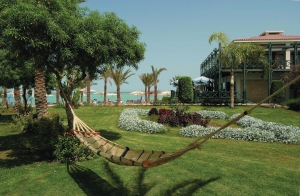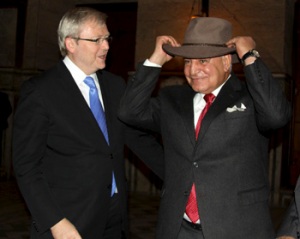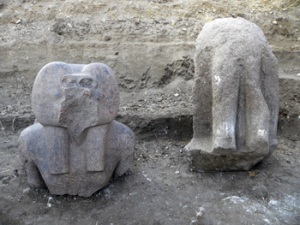
Egypt can be the perfect place for couples to rekindle their romantic spark, or just keep the fires burning hot in some of the most romantic spots in the world. That is, if you know where to look. Egypt Today has scoured the nation in search of the best destinations to partake in candle-lit dinners, walks on the beach and oasis spa treatments.
Despite Cairo’s hectic pace, the capital has several nooks and crannies where couples can steal a quiet moment alone to watching the sun set over the Nile. There are few places in the city where you’ll find greenery, but Al-Azhar Park is the best of them. The parkis a wonderful escape from Cairo’s urban stress. Atop the park’s main hill is an ideal spot for a picnic and offers a great view of the Citadel. For those who would rather enjoy finer fare, two cafés on-site offer a variety of salads, main courses, coffees and Arab sweets. One of the cafés overlooks a small lake, while the other has a garden vista.
Nothing says amour in Cairo like a felucca along the Nile at sunset. Though there are boats, such as the Grand Hyatt’s Marquise, that offer dinner and a belly dancing show, there is a certain je ne sais quoi about hiring your own private love boat for an hour.
Memories by the Mediterranean
The best part of Alexandria is its long stretch of beaches, from Qait Bay Fortress all the way to Montazah. Start your day with breakfast (or brunch) at the Helnan Palestine Hotel inside Montazah Gardens, where you can enjoy freshly-made croissants and a gorgeous view of the beach. If you own a cabin in Montazah, take advantage of it; beaches like Nefertiti and Cleopatra make intimate and discreet picnic spots.
For lunch and dinner dates, walk along the Eastern Harbor’s Corniche to the area around Qait Bay Fortress. The Greek Club overlooking the harbor and fortress is bound to delight your partner, as is the Chinese restaurant on the rooftop of the Sofitel Cecil Hotel, with its sweeping view of the entire harbor.
The Breathtaking Red Sea
Wherever there’s a beach, there’s bound to be a romantic spot, but settle only for the best. The Red Sea’s top two favorites are El-Gouna and Marsa Alam. El-Gouna is the spot to see and be seen for both couples and singles alike. Lazing by the beach is an El-Gouna staple, but couples looking for an extra thrill can take wake-boarding or kite-surfing classes together.
Come nightfall, a candlelight dinner at the French restaurant Bleu overlooking the marina is a must. Following dinner, couples can take a midnight stroll by the boats or dance the night away at Tabasco. The club is popular, but not too crowded, so you can enjoy dancing with your date without too much intrusion.
If you’re having trouble sealing the deal with a special someone, Marsa Alam is the perfect place to sweep them off their feet. During the day, go snorkeling with the dolphins at Samadai Reef, better known as the Dolphin House. Follow it up with a picnic on the coast, where oftentimes you can have a whole beach to yourself.
As the moon rises, cuddle up in any of the cafes on the beach (literally, on the beach), and watch the stars emerge while sipping freshly brewed tea from the mountains. Marsa Alam has several posh resorts along the coast like Kahramana Beach Resort, or simpler and more environmentally friendly huts, tents and stone chalets, such as Ecolodge Shagara. For a top of the line Marsa Alam experience, stay in Port Ghalib, a luxurious resort community with five-star hotels and a shopping street, as well as a lagoon and marina.
Desert Dreaming
Are you and your significant other having trouble getting some time to yourselves? There’s nowhere more isolated than a oasis in the middle of the Western Desert. Siwa’s easygoing people, delicate organic cuisine and accommodations seemingly designed with the romantic desert getaway in mind make the oasis an undiscovered gem for couples.A quick romantic evening that doesn’t take much planning is a Bedouin dinner amid the dunes. Most hotels offer forays into the sand or can recommend a good guide with an off-road vehicle.
There are also several springs to visit in the area, such as Cleopatra’s Bath, Fatnas Spring and Bir Wahed lake, where couples can have a picnic and swim.
Bahareyya, Farafra, and Al-Dakhla oases also offer worthwhile excursions for adventurous couples and are a good starting point for deep desert tours. From Bahareyya and Farafra, arrange a tour of the Black and White deserts, coupled with nights under the stars in a Bedouin camp. Private or group tours can be arranged in the towns or through your hotel. But before you go, spend a lazy day of reading and eating dates underneath palm trees in any one of the tiny hotels in the oasis towns and get a real feel for life in a small village out in the middle of the desert.
Sinai
Sharm El-Sheikh is a no-brainer for couples, with its long stretches of beach, resorts and exclusive private yachts for rent. But for a more intimate experience, try Ras Shitan, about 15 kilometers from Nuweiba. Its quiet beaches and pristine desert landscape can’t be beat.
If camps aren’t your thing, but you still want to avoid Sharm’s resort-laden coast, try Dahab. Known for its great diving, Dahab’s hotels and hostels near the Eel Garden are great places to spend quality time with your loved one while sipping a fruit shake in the sun.
Climbing Mount Sinai during the night to see the sunrise is the way most people do St. Catherine. Sunrise is the traditional goal of the climb, and it is definitely worth seeing, but you will be sharing the experience with a few hundred other dawn devotees. For a more intimate experience, make the hike in the afternoon so you can sit in silence and watch the rays of the setting sun paint the surrounding mountains in dramatic reds and oranges.
Upper Egypt
In the capital, feluccas and dinner cruises reign on the river, but for a proper multi-day cruise, Upper Egypt is the place to be. Nile cruises start from either Aswan or Luxor and range from three to seven days, depending on direction and number of stops. These floating hotels take care of all the planning for you, from transportation and tickets to the antiquities sites along the way to full board meals and evening entertainment programs.
The one drawback to a Nile cruise is its popularity. There are tens of cruise ships en route at any given time, except when the Esna locks are closed for maintenance in June and December, so the river gets awfully crowded near the tourist sites. A more isolated option is the Lake Nasser cruise: there are less than 10 boats authorized to operate on the world’s largest man-made lake. In addition to visiting a number of little-known antiquities sites, you and your companion can sip mocktails and clink glasses as you cross the Tropic of Cancer.
Known as one of the most beautiful places in the country, Aswan is a treat for couples with a yen for exploring. It’s a wonderful place to enjoy sunrises and sunsets while indulging with your evening or morning ahwa. One of the most picturesque corners of the country is Philae Island, with the Greco-Roman temples amid the flowering landscape.
After taking in the local ruins, particularly on Elephantine Island, check out the Sharia Al-Souq. Behind conventional shops and touristy peddlers are winding alleys with market fare accented by the city’s Nubian roots. Off the beaten path is Sculpture Park, home to world-renowned works from international sculptors. The park, housing the art created during Aswan’s annual sculpture symposium, is on the way to the Philae Island boat dock, so arrange transportation in advance. et et
Refernce: Egypt Today.





